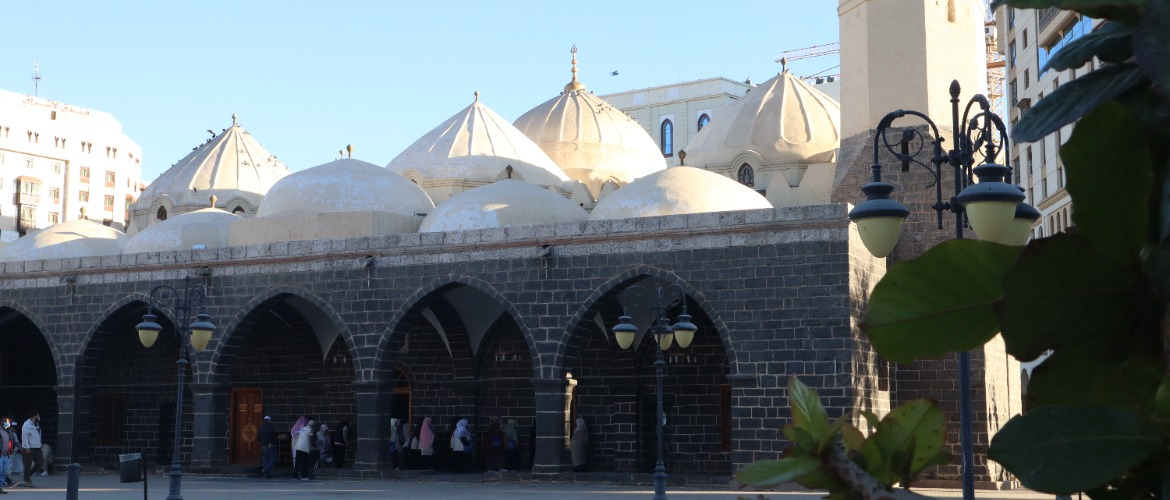Walkin tour.
Al-Ghamamah Mosque
Al Ghamamah Mosque is northwest of the wall of the Prophet's Mosque. It is narrated that it was built in the last placd where Prophet ﷺ prayed Eid prayers. It took its name after the clouds shaded the Prophet ﷺ while he was delivering sermon. The Mosque is of rectangular shape, built with black basalt stones and roofed with a nuber of domes. The domes and walls are white on the inside whereas the pillars and arcs ar black, which gives the Mosque a unique appearance.
Mosque of Abu Bakr Al Siddique RA
Abu Bakr's Mosque RA is located at about 1000 m southest of the wall of the Prophets's Mosque. It is narrated that the Messenger ﷺ prayed the Eid prayer in this place and Abu Bakr did the same after him during his Caliphate. Hence, it was named after him. It was built for the first time in the Era of Umar Ibn Abdul-Aziz in Madinah between 86-91 AH and renovated by the Ottoman Sultan Mahmoud II in 1254 AH / 1838 AD
Mosque of Umar Ibn Al-Khattab
The Mosque of Mosque of Umar Ibn Al-Khattab RA is located it distance of 200 m south of Abu Bakr's Mosque. It was built by Shamsudeen Ibn Ahmed Al-Silawi in 850 AH / 1446 AD in one of hte places where the Prophet ﷺ prayed Eid prayer. Umar Ibn Al-Khattab prayed there after him, and so it was attributed to him.
The Mosque is square shaped with a length of 8 m and has an open rectangular courtyar of 3 m x 12 m. The Mosque is built with basalt stones and the interior is painted white. The dome is 12 m high and the cylindrical minaret is 8 m high in the north-western corner.
Mosque of Ali Ibn Abi Talib RA
The Mosque of Ali Ibn Abi Talib RA is 300 m northwest of Al-Ghamamah Mosque. It is reported to be on of the positions in which the Prophet ﷺ prayed the Eid prayer and Ali Ibn Abi Talib RA prayed the Eid prayer there after him. The Mosque was built for the first time during the Era of Umar Ibn Abdul Aziz betwen 87-93 AH / 706-712 AD. The building is rectangular, 31 m long and 22 m wide. It has a dome over the niche which opens from the north side to an open rectangular courtyard. There are a further seven domes covering its' portico and a minaret on the eastern side.
Saqift bani Sa'idah
The roofed chamber of the Bani Sa'idah. The Saqifah lies to northwest of the Prophet's Mosque, where the homes of bani Sa'idah Al-Khazraj, the clan of the venerable Companion, Sa'd Ibn Obadah RA, use to be stationed, and it was one of the districts of the Ansar. It was built in the form of a rectangular structure roofed in its three sides while the fourth side was kept open.
The Saqifah is famous because it was the place where the Companions net after the death of the Prophet ﷺ and gave allegiance to Abu Bakr RA as Caliph. Later, it become a proper structure, which changed shape throughout the history, until it was recently demolished and a garden was placed in it location.
Courtyard - Around Prophet's Mosque
To the north of the Prophet's mosque, lies Mount Uhud at a distance of 4 km, in front of which the second battle in Islam (the Battle of Uhud) took place in 3 AH. At its foot, there is a cemetery containing 70 Companions of the Messenger ﷺ who were martyred in the battle of Uhud. In their forefront was his Uncle, Hamzah Ibn Abdul Muttalib RA. The cemetery was visited by the Messenger ﷺ from time to time. Of this mountain, the Prophet (ﷺ) declared, “This mountain loves us and we love it.” [Muslim]
The Baqi' Cemetery
The Seven Mosques or Sab'u Masajid is a complex of six small historic and often visited mosques in the city of Medina, Saudi Arabia. The complex consists of six mosques in spite of the name "Sabah" means "seven", because it included the Masjid al-Qiblatayn originally.


